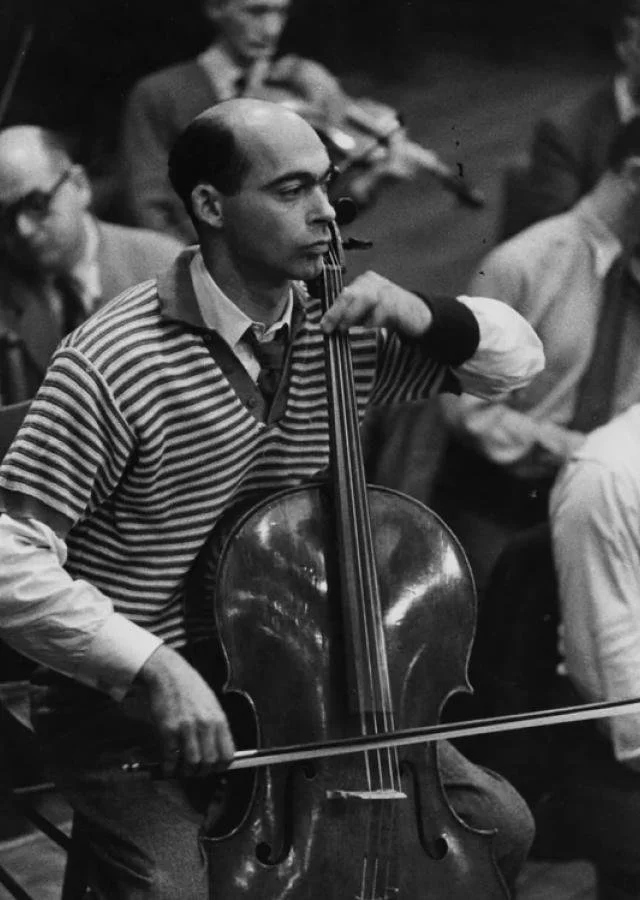Biography
János Starker (July 5, 1924 – April 28, 2013) was a Hungarian-American cellist whose precision, disciplined tone, and pedagogical influence established him as one of the most important cellists of the modern era.
Born in Budapest, Hungary, Starker began playing cello at age five, gave his first public recital at six, and was admitted to the Franz Liszt Academy of Music at eleven. His teachers included Adolf Schiffer, Leo Weiner, and Liszt Academy faculty Zoltán Kodály, Béla Bartók and Ernő Dohnányi. During World War II, Starker and his family were targeted under anti-Jewish policies; he survived internment, though his two brothers perished.
Following the war, Starker became principal cellist of both the Budapest Opera Orchestra and Budapest Philharmonic Orchestra. He emigrated to the West in 1946, first performing in Vienna and Paris before moving to the United States in 1948. In America, he held principal cello positions with the Dallas Symphony Orchestra (1948–1949), Metropolitan Opera Orchestra (1949–1953) and Chicago Symphony Orchestra (1953–1958).
He launched his full-time solo and teaching career in 1958 when he accepted a professorship at Indiana University Jacobs School of Music, where he remained for over five decades. He was named Distinguished Professor in 1962 and later Distinguished Professor Emeritus.
Starker recorded more than 150 albums, including three complete recordings of Bach’s Six Suites for Unaccompanied Cello, the most celebrated being his 1965 Mercury recording. He was awarded the Grammy Award for Best Instrumental Soloist Performance (1998) for his recording of the Brahms Cello Sonatas with pianist György Sebők. His repertoire ranged from Baroque to contemporary works, and he premiered several significant 20th-century pieces.
A demanding and influential pedagogue, Starker developed a highly systematic approach to cello technique emphasizing economy of motion, maximum control, and clarity of articulation. His students have become leading soloists, orchestral principals, and professors throughout the world.
János Starker died in Bloomington, Indiana on April 28, 2013, leaving a legacy regarded as foundational to 20th- and 21st-century cello performance and education.
Books
The World of Music According to Starker
By Janos Starker (2004)
Janos Starker is universally acknowledged as one of the world's great musicians. Known for a flawless technique paired with expressive playing and interpretation, the Hungarian-born cellist is arguably also the premier teacher of his instrument in our time. String players flock to his masterclasses from all over the world, and cellists compete vigorously to study under him at the Indiana University School of Music. More than the consummate musician, however, Starker is also a raconteur and writer, occasionally quirky and droll, always witty and with a pointed opinion to share.
The World of Music According to Starker is a colorful autobiography spanning the author's fascinating life. From his early musical education during World War II in Hungary, to his world tours, educational philosophy, and recording and pedagogical legacy, Starker takes the reader on a riveting, entertaining, and informative journey. Included in the book are several of Starker's short stories and commentaries on world events, academia, and—of course—music that have appeared in newspapers, music periodicals, and trade magazines.
Also includes a bonus CD recording of Starker's last public recital, which is unavailable commercially and includes his only recording of the Strauss Sonata in F, Opus 6.
Top Secrets for Cellists: An Organized Method of String Playing
By Janos Starker (1965, re-edition 2022)
"Handbook and guide" …for Cellists and all other String Players.
”The contention is that in order to produce music on an instrument one has to learn the available steps as one learns the the combinations thereof will provide us with syllables, then words (phrases), and eventually the ability to play a musical composition will come within reach. Too often gifted instrumentalists learn to jump and skip without the awareness of how to walk. Many times discussion of fundamentals was half understood and the exercises became distorted and misused. Therefore, I have decided to publish this complete method. It is intended to show the mathematical possibilities on a four string instrument; in this instance the instrument is the violoncello.”
The Roll Call of the Blessed Ones
By Janos Starker (text) & Jorge Sicre (drawings) (1997)

